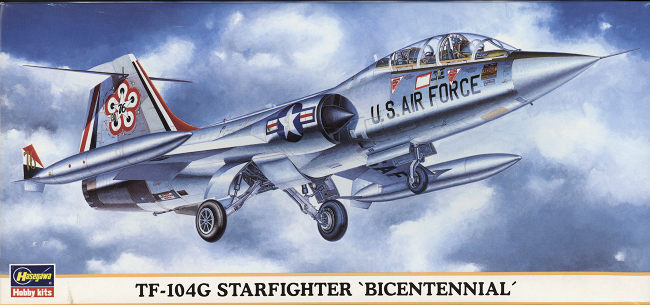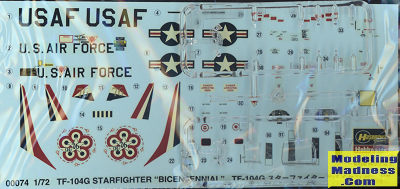
Hasegawa 1/72 TF-104G "Bicentennial"
| KIT #: | 00074 |
| PRICE: | 1400 yen |
| DECALS: | One option |
| REVIEWER: | Scott Van Aken |
| NOTES: | 2000 limited edition. |

| HISTORY |
The first production fighter to exceed Mach 2, the F-104 was highly touted as the 'Missile with a Man in it'. Designed to provide the smallest airframe possible in an interceptor, the F-104 was to be the USAF's premier fighter aircraft. However, delays in getting the aircraft into production caused a huge order cancellation and concentration on the F-101 and F-106 to fill that role. Heavily marketing the aircraft to NATO countries ready to shed their F-84Fs for something more modern, the Germans were the first to buy into what was now going to be a tactical nuclear strike aircraft. Much airframe work had to be done to allow what was initially a high altitude interceptor to function as a low level tactical strike aircraft.
Lockheed was successful and despite an alarmingly high initial fatality rate with the plane (mostly from those transitioning from the sedate F-84/F-86), it eventually became a superbly reliable aircraft for many NATO countries and functioned equally well as an interceptor, a role it was performing with the Italians when finally pulled from service. As with any modern jet fighter, a trainer was mandatory and so, the subject of this kit, the TF-104 was developed.
| THE KIT |
 Hasegawa's
F-104 kit has been around now for quite some time and while it doesn't seem like it to
many of us, but it is so. As is often the case with kits, especially in 1/72,
new molds are often few and far between, but really, there is little need for a
new mold 104 for the huge majority of modelers as Hasegawa's is a beauty.
Hasegawa's
F-104 kit has been around now for quite some time and while it doesn't seem like it to
many of us, but it is so. As is often the case with kits, especially in 1/72,
new molds are often few and far between, but really, there is little need for a
new mold 104 for the huge majority of modelers as Hasegawa's is a beauty.
In an age of multi-variants, this one is no exception. Of the four major sprues, three of them are for generic F-104, while one is for the two seat version. This later sprue contains a new nose, new seats, new gear doors, new nose gear and new cockpit tub amongt the bits. The rest is standard F-104. At least, standard Hasegawa F-104. Some of the salient features are bulged and 'flat' main gear doors, two sets of main wheels, a set of wing pylons and tip tanks as well as an alternate seat (same as one included with the TF sprues. The instrument panels have nicely raised detail and are molded in clear plastic. Raised detailing is on the consoles as well. Decals are provided for these in case one wants to use them. Clear bits (not shown) are very nicely molded and quite thin. As the main sprues have been used a lot, I was not surprised to find some flash on several of the finer parts.
 This particular boxing is for
the bicentennial bird of the 418 TFS/58th TTW at Luke AFB. This unit was tasked
with training NATO Starfighter pilots so they had several two seat planes. In
fact, it may well be that these were planes that were paid for by the
Bundeswaffe, an arrangement also made with 80 TFW T-38As. The holes in the lower wing for the pylons must be
filled unless one is going for a plane carrying wing tanks. The plane is overall
unpainted metal with darker metal areas around the exhaust. Wings are white on
the upper side and ADC grey on the underside. The nicely done decal sheet is old
school Hasegawa where the whites are actually off white so you may wish to look
for aftermarket.
This particular boxing is for
the bicentennial bird of the 418 TFS/58th TTW at Luke AFB. This unit was tasked
with training NATO Starfighter pilots so they had several two seat planes. In
fact, it may well be that these were planes that were paid for by the
Bundeswaffe, an arrangement also made with 80 TFW T-38As. The holes in the lower wing for the pylons must be
filled unless one is going for a plane carrying wing tanks. The plane is overall
unpainted metal with darker metal areas around the exhaust. Wings are white on
the upper side and ADC grey on the underside. The nicely done decal sheet is old
school Hasegawa where the whites are actually off white so you may wish to look
for aftermarket.
| CONCLUSIONS |
Hasegawa did produce an F-104G/J back in the 70's, but that one is crude by the standards of this kit and they did not do a two seat version. Only Heller did a TF-104 and while it makes into a nice model, this one is even better. Probably the only issue will be finding one. However, the standard boxing is always available if you don't mind shopping Japanese retailers.
April 2018
Copyright ModelingMadness.com. All rights reserved.
If you would like your product reviewed fairly and quickly, please contact me or see other details in the Note to Contributors.